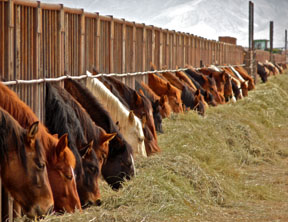Expanded Associated Press Version
Yesterday we wrote on how the AP did a limited job of telling both sides of the story on the Calico/Fallon Wild Horse deaths. Today, the following story was released with quotes from Makendra Silverman from the Cloud Foundation.
Although thankful for hearing the other side of the story there is still so much more that could be told.
Click HERE for the story.
Categories: Horse Health, Horse News, Wild Horses/Mustangs



![Reblog this post [with Zemanta]](https://i0.wp.com/img.zemanta.com/reblog_e.png)






Lord, that photo is so heart-breaking….reminds me of the cattle feedlots.
Treating horses like cattle…I suppose I shouldn’t be surprised. After all, Cattoor, BLM aren’t horsemen…they are cattle/sheepman.
LikeLike
Does the link work? I can’t bring it up.
LikeLike
The war of the migrating link. Try again, we reassigned it.
LikeLike
I’m putting this up again because I’m upset.
I agree getting some sort of story out was a good thing. No news is bad news, and I suppose we should be grateful for any crumbs tossed our way. After one news cycle, it’s “old news” – water over the dam. Keeping it “fresh” will require new, different, and hopefully more shocking articles.
In my opinion, adding “in Nevada” to the first sentence implies it’s a regional rather than a national issue. I consider including what JoLynn Worley said (notice no direct quotes), and omitting what Makendra said (as well as her credentials) bad journalism.
I believe AP violated its own “News Values and Principles” by not “identifying all sources of information”, as well several other areas. Here’s the link:
http://www.ap.org/newsvalues/index.html
Essentially, this story was rewritten, not edited.
I was surprised the Washington Post chose to print the “short version”, and wonder where they put it. At least they provide “Who’s Blogging – Links to this article” should anyone want a bit more information “directly related” to the article. R.T. – this post and your previous post are included.
Most newspapers have become no more than advertising vehicles and dedicate column-inches accordingly. TV and radio outlets choose “sound bites” due to time constraints. Thankfully, we have the web – 24,400 posts so far, traditional media overwhelmingly the rewrite. Maybe folks will do more research.
LikeLike
Both the Nevada Appeal & Reno Gazette Journal have published this story; Nevada anti-Equines can be a fairly brutal bunch when it comes to ‘native’ vs. ‘indigenous’; most of the time they don’t even bother with the story – they just come out swingin’.
Speaking of Sunday – do we have any Observers in Fallon today?
LikeLike
The story was written by Martin Griffith.
LikeLike
Do we have any observers in Fallon anymore at all? God, I hope so.
LikeLike
They just get that short window on Sunday afternoons.
LikeLike
I heard the BLM was going to try this angle a couple of weeks ago..We MUST hit every news story that comes out introducing this “NEW” illogical storyline..Any idiot would recognise, that had there been the numbers of horses arriving from the gathers in starving condition..The BLM would have documented those cases with photos and videos..to prove claims of a lack of forage-not only have they not produced that, but had not stated that claim up until now on their update page. We must demand proof, before they use this to corrupt americans knowledge of what is happening here..This is a begining of a new strategy..and we need to refute it every place it is posted..I also read that the horses were full of worms and ticks…where are wild horses that roam thousands of acres picking up worms? And they do have them, as 1 observer has seen after the wormings…and yes tick infestations will cause animals to loose weight..usually tick infestations come with large deer populations..Is BLM having a problem with starving deer? The cattle are also notorius for tick infestations.
LikeLike
It’s important to hit every news story because I am assuming that the “other side” probably contacts the press on a regular basis to spell its arguments. That’s how stories get printed.
LikeLike
http://www.lahontanvalleynews.com/article/20100320/NEWS/100329992/1001&parentprofile=1045#comments
LikeLike
Fact Check Alert!!!
According to about 50 articles Googled (I really hate that term), parasites, specifically worms in Desert Wild Horses, are seriously hard to come by; they do exist in very small numbers BECAUSE of the way Wild Equines are forced to graze, but in the desert, almost never reach health-threat proportions. Parasite worms are diagnosed by lab tests on fecal matter. I’m not real convinced our holding facility vet has time or money for ‘lab tests’.
Parasite worms are most often transfered through fecal matter. Wild Horses tend toward ‘community toilets’, areas away from forage, and distribute them so the desert dries fecal matter and kills the parasites, a case study for not crappin’ where you eat. Wild Ones also ‘self medicate’ on plants that have mild poisons in them (Natural Horse Magazine,National Geographic).
This link is a picture tour of common ticks.
http://entomology.ucdavis.edu/faculty/rbkimsey/caticks.html
I can find no data on ticks in Wild Equines. Most articles seem to focus on ticks passed from animal to animal under domestic conditions, deer ticks and the Sierra Nevadas.
Straw graspin’? Maybe. But -and I blame this on all of YOU – I question everything that comes outta the BLM mouth.
LikeLike